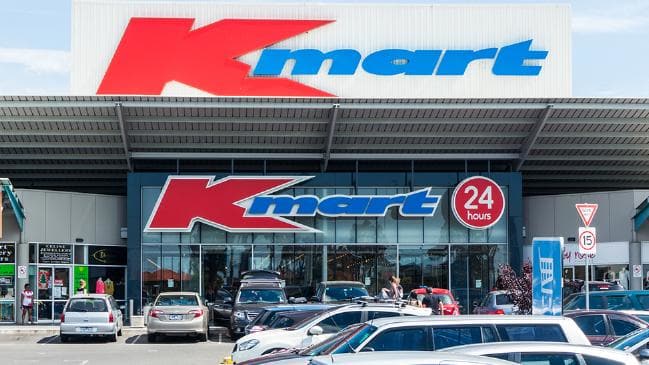
This article is more than
7 year oldFrom Kmart to Big W and Ikea, here’s what the initials in big retailers’ names stand for

IT’S one of the most recognisable retail brands in Australia. So much so that we hardly give the name a second thought. But what does Kmart actually mean? Not the Mart but the K?
Much as Kmart bosses might wish it, the K doesn’t stand for “Krackin’” value. Sadly, it also doesn’t stand for “Kooky Kitchenware of Kwestionable Kwality”.
And for that matter what does the W mean in Big W. Was there ever a TK of TK Maxx fame? And what do the letters H&M mean in, well, H&M?
Our suburban shopping strips and centres are littered with companies whose original names have now been boiled down to mere initials. But those initials, the original meaning of which is forgotten today, often reveal a gem or quirky fact of the history of the company.
In some instances, businesses can attempt to change the meaning of their initials. British Petroleum, better known to the world as BP, decided in 2000 that its name now stood for “beyond petroleum”. Which sounds like the corporate waffle it indeed was.
Some initials we see every day are probably quite obvious. ANZ is the Australia and New Zealand Banking Group; BWS stands for “Beers, Wines and Spirits”. But others are a little more esoteric.
So, let’s start with one of the biggest retailers in the land.

KMART
We had a chat to Kmart about what the big red K stands for and they told news.com.au that officially the K doesn’t stand for anything and the brand has only ever read in Australia as “Kmart”.
“We trademarked the Kmart name back in 1969. For us Kmart is the place where families come first for the lowest prices on everyday items,” a Kmart spokeswoman said.
But, they concede, the letter K wasn’t plucked from thin air. When Kmart arrived on Australia’s shores it was a joint venture between Coles supermarkets and the brand’s US owners.
These days, Kmart Australia is fully Aussie owned and has no connection to Kmart USA, but the K still references its stateside founding.
The American company’s history goes back to travelling salesman Sebastian Spering Kresge from Pennsylvania. In 1897, he opened his first store in Memphis and by the 1950s Mr Kresge had 600 stores bearing his surname.
The stores began to convert to the simpler Kmart brand in 1962, the K a nod to its founder. Mr Kresge died in 1966, three years before the first Kmart opened in Australia.
With the US Kmart currently in a world of retail pain, Australia and New Zealand could soon become the only places where the Kresge legacy remains.

BIG W
Kmart’s cutthroat rival also likes an initial. But staff at Big W are straightforward about what the W is about.
“The Big W chain grew from Woolworths’ original ‘Variety’ stores, which carried a small range of general merchandise products. Big W’s name is a reflection of the close relationship the brand has with Woolworths Supermarkets,” a spokeswoman said.
The first Big W store opened in 1976 in Tamworth, NSW, when the company decided to make the divide between its two types of stores more distinct. Supermarkets retained the Woolworths name while other stores took on the new badge.

However, many of us could now be doing our weekly shop at “Christmas” but for on oversight in New York.
It was one Percy Christmas who, in 1924, decided to set up a shop in Sydney’s CBD.
The obvious thing to do would have been to put his own name above the door. But on discovering the New York based FW Woolworth Company hadn’t trademarked their name in Australia, Percy decided to name his new shop the “Woolworths Stupendous Bargain Basement”. And it’s that store that became the Woolies we know today.

H&M
The Swedish fast fashion powerhouse may be relatively new to Australia but Europeans have been happily sorting through racks of reasonably priced clothes since the late 1940s. Many of those still refer to the store not as H&M but as “Hennes”, the original name.
However, Hennes is no Stockholm surname. Rather, it’s the Swedish for “her” as the original stores only stocked women’s fashion.
Two decades later Hennes acquired men’s outfitters Mauritz Widforss and Hennes and Mauritz, or H&M, was born.

ALDI
Not a group of initials but a portmanteau — and a globally famous one at that — it shines down from buildings it its home town of Essen, Germany, to not far from Essendon, Melbourne.
Anna Albrecht opened a grocery store in 1913. Her sons eventually took the business on, and in 1962 decided they needed a rebrand. They combined the “Albrecht” family name and the word “Discount” and ended up with Aldi.

IKEA
An acronym, the “IK” in the furniture giant’s name is the initials of founder Ingvar Kamprad. The Swedish farm he grew up on was called Elmtaryd, within the village of Agunnaryd. They later provided the E and the A.

TK MAXX
The discount clothing store is a relatively recent entry to Australia, rebranding Trade Secret stores in 2017. But its US owner isn’t TK Maxx at all, but TJ Maxx. How come?
In 1994, TJ Maxx made its first foray overseas to the UK. But crumbs! In Britain a discount retailer called TJ Hughes already existed. It still does. So, the company subtly changed the name. Ever since then, every store outside the US has been a TK rather than a TJ.

JB HI-FI
JB was founded in 1974 by John Barbuto who selflessly gifted the first store, in East Keilor, Melbourne, with his initials.
Since then JB has gobbled other companies including Queensland’s Clive Anthony’s and The Good Guys, the latter of which retains its name.

ASOS
The British internet retailer that every bricks and mortar retailer equally hates and tries to emulate started life as a website called AsSeenOnScreen. The idea was that mere mortals could buy clothes they’d seen celebrities wearing “on screen”.
As the company grew, so did its range, so the name was shortened and the ASOS (pronounced “ace-oss”) acronym emerged.

BUPA
Pronounced “boo-pa”, there’s no wonder one of Australia’s largest life insurers never says its name in full. The British United Provident Association sounds like something out of the 1940s, because it is. In more modern times, Bupa will do nicely.

LCMs
Not actually a store, but the Kellogg’s cereal bars can be found in lots of them, so what does it stand for? Over to Kellogg’s: “We get this question all the time. LCMs doesn’t stand for anything in particular,” a Kellogg’s spokesman told news.com.au last year.
“We wanted to find a name that was catchy and a bit different and LCMs seemed to hit the mark. We wish we had a better story for you, but we just liked the way the letters sounded together.”



